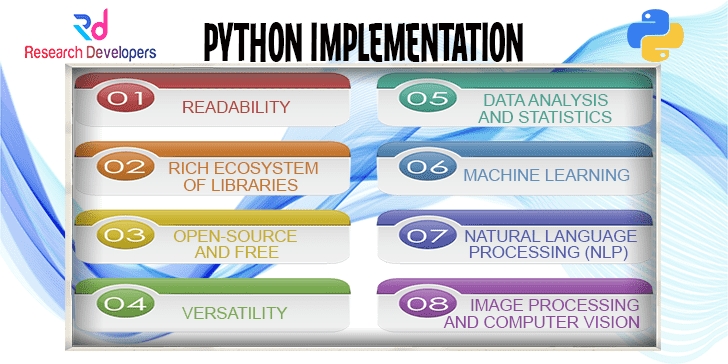Python Implementation
Where research begins: Expert guidance on topic selection.

Python Implementation
Python was created in 1989 by Guido Van Rossum. This computer language’s interpreter is an open-source undertaking. Python is a multi-language programming environment that supports functional, procedural, and object-oriented programming styles. Python is an adaptable programming language that works on a wide variety of platforms, including Windows, Linux, and Unix-based systems like Mac OS X. Programmes can be readily reproduced by copying the source code because it has excellent support for both standard and third-party libraries.
Due to its powerful tools that are in sync with cognitive processes and code execution, the Python programming language comes highly recommended as an initial language for beginner programmers. It also makes it easier to construct syntactically correct programmes by reducing the amount of extra keywords needed. The efficacy of this approach appears to surpass that of instructing C++ or Java languages, as the latter encompass a multitude of terminology and components that pertain to the intricacies of a language rather than the implementation of algorithms. In contemporary times, it is imperative for computer scientists to acquire proficiency in at least one programming language. This is due to the fact that the development of innovations and technologies heavily relies on a comprehensive comprehension of computers, operating systems, software APIs, and other hardware peripherals.
All of these are developed by programmers who employ a distinct cognitive approach. In order to cultivate such a mindset, individuals must familiarise themselves with a specific programming language and acquire proficiency in the field of software development. For individuals embarking on programming, it is crucial to prioritise programming fundamentals over language specifics, as they may vary across different programming languages.
Python is a high-level programming language used for multiple applications that include working on research of data mining, data management, and others. This programming language is supported in many operating systems. Python has the ability to manage and process a large-scale database in a composition of different types of data.
• Python is used for performing image processing concepts since it consists of a special library for processing images. The libraries in python that are used for image processing are OpenCV, SimplelTK, SciPy, and others. The process that is carried out in python is morphological functions, preprocessing, denoising, edge detection, shape detection, classification, and so on.
• Security provisioning by python activated on the detection of insider threats which majorly participates in an organization. These threats are difficult to determine as they belong to the same organization. For this system, python introduces libraries like pandas, Scikit-learn, Tensorflow, and others.
Python is a language that is well-suited for both educational purposes and practical application in programming. Python, developed by Guido van Rossum, is a robust object-oriented programming language known for its high-level capabilities. Initially, we present the distinctive attributes and functionalities of Python programming. Python is a programming language that is open source, interpreted, and high-level. A strong foundation for object-oriented programming is provided by it. When it comes to data science, this language is second to none for all sorts of projects and uses. Python has many features that are made to be used for scientific, statistical, and mathematical work. In order to put data science to use, the platform provides extensive libraries.
Python is widely used in scientific and research communities because it is easy to learn and use, even for those without engineering backgrounds, thanks to its plain syntax and user-friendly nature. It also works well for quick prototypes. Regarding its application domains, Python is also preferred by machine learning specialists. Java has been the language of choice for developers working on algorithms for fraud detection and network security. Python is preferred by developers for applications like sentiment analysis and natural language processing (NLP). One reason for this preference is Python’s large library, which helps in solving complex business problems and creating reliable systems and data apps.
The easiest thing to do using Python is to write a “Hello World” application. Among other things, many programming languages require the development of a great deal of custom code, including methods, functions, class declarations, and programme declarations. However, Python provides the capability to initiate programming without the need for such prerequisites. Python is an interpreted programming language, allowing students to conveniently examine the functionality of operators or functions through the utilisation of a command-line interpreter.
The Python interpreter is equipped with an integrated assistance module that can greatly enhance the comprehension of several language elements. Freshmen, who lack programming knowledge, must acquire the ability to think like computer scientists in order to comprehend programming languages. This necessitates a significant exertion and a fundamental change in their cognitive framework. The implementation of Python code is sufficiently straightforward, such that individuals who have completed a basic mathematics course will find the utilisation of tools such as “variables” and “functions” to be user-friendly.
Python, because to its extensive library, can be employed by programmers when they require a software prototype. If necessary, the software can be rewritten in a more concise language. The advantages of Python are substantial, hence employing it as the principal programming language can have a profound impact on the overall pace of computer science education.
Python lacks security features such as public/private/protected, resulting in a simpler and more concise programme that is more stringent and comprehensible. Python is highly dynamic, allowing for the creation of fields and characteristics in real-time, a feature that is not available in C++ or JAVA. The nature of class methods and Python functions is characterized by polymorphism, in contrast to C++ which employs non-virtual or virtual methods. Operator overloading in Python provides enhanced functionality to Python objects, as it allows for the utilisation of any natural expression, in contrast to the constrained syntax of JAVA.
The utilisation of programming indentation in Python significantly contributes to the organisation and structure of a programme, hence facilitating its readability and comprehensibility. However, in the context of JAVA or C++, students often strive to condense their programmes by condensing them into a single line or employing consistent indentation for each statement. This approach might result in a programme that is challenging to understand and comprehend, not only for the instructor but also for the student. Python incorporates a wide range of sophisticated algorithms within its native libraries.
The student does not require a comprehensive understanding of complex arithmetic in order to perform large-scale calculations. The native long data form in Python already exists. There exist effective tools for organising, locating, dividing, and merging any sequence of data. Occasionally, they may lack effectiveness, particularly when developed in C++ for certain objective. However, for novices, it is not the foremost concern.
Python possesses a distinct methodology for the storage and utilisation of variables, hence obviating the necessity for programmers to explicitly specify the types of variables. Instead, the definitions of variables are determined by the values they hold. Understanding the storage of various sorts of variables in memory is crucial. This topic could be covered in lectures, but for practical purposes, it is more convenient to omit the understanding regarding data types. Python possesses a versatile and user-friendly collection of keywords and commands that effectively facilitate the acquisition of programming skills among pupils.
Python takes a major part in the fields of PhD research to retrieve optimum results. The python language can be programmed for intrusion detection, network routing, flow management, traffic flow detection, and many other processes.
In this way, python is used for validating different methods that can be machine learning, deep learning, and optimization. In academic study, the novelty and its outcome are significant which is to establish your knowledge.
Our Implementation in Python will be completely under your control. We start to prepare a procedure for your concept and based on that concept, the implementation is carried out. So you can join our team and finish your PhD. Apart from implementation, we also do proposal writing, paper writing, this writing, and dissertation writing.
Other Services
- PHD & POST DOC Admission counselling
- Topic Section
- Review Paper Writing
- Systematic Literature Review (SLR)
- Research Paper Writing
- Synopsis Writing/Pre thesis writing
- Thesis Writing
- Data Analysis
- Questionnaire Preparation
- Developing Research Framework
- Methodology Development
- MATLAB Implementation
- Matlab Simulation
- Python Implementation
- Machine Learning Implementation
- Deep Learning Implementation
- VHDL Implementation
- Hadoop
- NS2 Implementation
- NS3 Implementation
- ArcGis Mapping & Analysis
- Spss Data Analysis
- Stata Data Analysis
- Amos Analysis
- R Programming
- E-Views Data Analysis
- Minitab Data Analysis
- Software Testing
- Ansys Implementation

